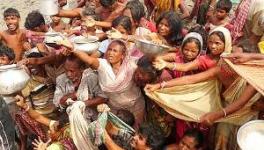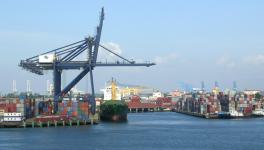Rapid Growth Under Neo-liberalism Accompanied by Increase in Poverty

Growth under capitalism is associated with an increase in absolute poverty. Marx had recognised this and expressed it as follows: “Accumulation of wealth at one pole is, therefore, at the same time accumulation of misery, the torment of labour, slavery, ignorance, brutalisation and moral degradation at the opposite pole, i.e. on the side of the class that produces its own product as capital” (Capital Volume I); or again, “As productive capital grows…the forest of uplifted arms demanding work becomes ever thicker, while the arms themselves become ever thinner” (Wage Labour and Capital).
The Indian experience bears this out. It is generally accepted that the period of neo-liberalism witnessed rapid capital accumulation and hence rapid growth in GDP. This period is hailed for that reason as ushering in an altogether new era in India’s economic history. And yet, this very era saw an increase in absolute poverty. The per capita foodgrain availability reached in 1991—by reversing to an extent (though by no means fully) the disastrous decline that had occurred over the last half-century of colonial rule—was never reached again in any subsequent year.
Food consumption data are even more telling. In 1993-94, the first year after the introduction of neo-liberal policies when an National Sample Survey (NSS) large sample survey was conducted, the proportion of rural population that could not access 2,200 calories per person per day, which is the definition of poverty in rural areas, was 58%. In 2011-12, the last year for which data from a similar NSS survey are available, this proportion had increased to 68%. For urban areas where the benchmark for poverty is a calorie intake of 2,100 per person per day, the corresponding figures were 57 and 65%, respectively.
Precisely over the period of neo-liberal capitalism in short, there had been a perceptible increase in the extent of absolute poverty defined in terms of its most elemental manifestation, namely hunger. It also was the basis of the official definition of poverty, until it became so embarrassing for the government that all sorts of definitional subterfuges began to be adopted to produce a more prettified picture.
This conclusion about growing poverty is also corroborated by the available evidence on inequality. Piketty and Chancel, two French economists, who have estimated the share of the top 1% of the population in national income from income tax data, show that this share was the highest ever, 22%, in 2013 in the period after the income tax was introduced in India (in 1922); this share by contrast had been only 6% in 1982. No matter what specific criticisms one may have of the method used by the authors, their results are, too, striking to ignore. The growth of inequality in India under neo-liberal capitalism has been so sharp that it has actually resulted in an increase in poverty.
Also read: Why Agriculture Remains the ‘Sink’ for Indian Capitalism
The specific mechanism for this increase in poverty is exactly what Marx had underlined, namely a process of pauperisation of petty producers, especially peasants, many of whom migrate to cities in search of jobs that are insufficient in number. The migrants, and even a segment of the natural increase in the labour force, unable to find jobs, swell the reserve army of labour (in the sense often of sharing jobs with those already employed); they reduce the bargaining strength of even the organiwed workers, and hence worsen inequality and poverty.
This is a point I have written about in the past and need not labour further. But two wrong conclusions are often drawn from it. One, if growth produces an accentuation of poverty then the cessation of growth should have the opposite effect of alleviating or at the very least of freezing poverty: if process A causes process B, then the cessation of process A should cause a cessation of B. This inference is wrong because there is an asymmetry in the effects of growth and stagnation on poverty: if growth produces an accentuation of poverty, then the cessation of growth produces an even greater accentuation of poverty.
Growth produces an accentuation of poverty because, as we have seen, the petty producers and peasants are pauperised. Even when they do not experience a primitive accumulation of capital in terms of loss of land or other assets (i.e. in “stock” terms), they suffer a squeeze on their incomes, i.e. primitive accumulation in “flow” terms. The cessation of growth does not mean that the average income of a peasant or petty producer increases; on the contrary, it decreases further for a different reason.
Take a simple example. Suppose a peasant’s money income earlier had been Rs 100 because the value of his produce (quantity multiplied by price per unit) had been Rs 200 and the input costs (to be deducted) Rs 100. But, his real income had been squeezed because the privatisation of healthcare had greatly increased his medical expenses. Now, with the cessation of growth, medical expenses do not come down; but he can no longer get the same price for his produce, while input costs remain the same, so that his money income comes down. If the squeeze on him earlier had been through one mechanism, it now occurs through another mechanism without the first mechanism ceasing to be effective.
Likewise, if the real income of a working person is the product of two terms – the real return to work for a working day and the number of days for which work is available, then immiserisation associated with growth occurs primarily through a lowering of the real return per working day. The cessation of growth does not raise the real return per working day, but it reduces the number of days of work. Thus, even though high growth was accompanied by an accentuation of poverty, the cessation of growth becomes associated with an even greater accentuation of poverty.
Also read:The Indian Economy is Hurtling Toward Disaster
More generally, one can distinguish between non-recession-caused immiserisation and recession-caused immiserisation. The growth of poverty during growth is because of the first process; the further growth of poverty because of the recession is through the second process, without the first in anyway disappearing. Recession and stagnation, therefore, superimpose additional factors upon those already operating during the growth phase, to cause a further accentuation of poverty.
This brings us to the second question. Would the resumption of growth then entail a decline in poverty? The temptation would be to say: yes, it would do that but only by removing the additional poverty-causing factors that had been superimposed upon the basic factors operating even during the growth phase. And that once this process is complete, for instance through unemployment being reduced to the pre-recession level, then the process of secular accentuation of poverty alongside growth would resume.
This however is erroneous. The crisis faced by neo-liberal capitalism today is not a mere cyclical crisis but a structural crisis arising from the fact that the system has arrived at a dead-end. From this accentuated level of poverty that the recession has caused, even before the onset of the pandemic, there is no automatic revival; there can be revival only if purchasing power is put in the hands of the people, which means that the old kind of growth simply cannot resume.
Two bits of information summarise the extent of this recession-caused accentuation of poverty. I quoted figures for 2011-12 relating to rural and urban poverty. Since 2011-12, there has been another round of NSS large sample survey for 2017-18 which shows that per capita rural consumption expenditure in real terms has declined by 9% between 2011-12 and 2017-18. Since the per capita real consumption expenditure of the rural rich would have increased rather than declined, that of the large mass of the rural population must have declined to an even greater extent. This is so remarkable a finding that the government decided to withdraw altogether the NSS sample survey results from the public domain rather than have to answer awkward questions.
The second information relates to chronic unemployment, which, even before the pandemic set in, had reached 6%. Since much of unemployment in India takes the form of irregular employment arising from the fact that a given number of jobs are shared among many, the chronic unemployment is usually rather low, around 2 to 2.5%. The jump to 6% is thus extremely significant and underscores the magnitude of recession-caused accentuation of poverty.
Also read: Food Consumption Trends Point at Real Income Decline Before Pandemic
Get the latest reports & analysis with people's perspective on Protests, movements & deep analytical videos, discussions of the current affairs in your Telegram app. Subscribe to NewsClick's Telegram channel & get Real-Time updates on stories, as they get published on our website.
























